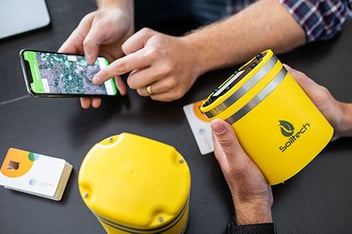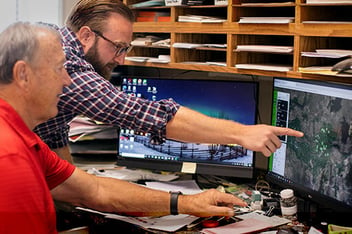It's Time For a Consolidated Tech Stack in Agriculture
The writer Victor Hugo famously said, “All the forces in the world are not so powerful as an idea whose time has come."
Friends, the time has come for an agricultural technology stack.
Farming is an old business. However, we should not make the mistake of assuming that “old” means stagnant or backwards here; when technologies are presented in a way that fits into a farmers framework for value, they are adopted faster than consumer technologies. The profession of farming is old because of its demonstrated ability to respond to problems with innovative solutions.
- When harvesting by hand limited our ability to expand the size and output of farms, farmers adopted Cyrus McCormick’s mechanical reaper.
- When using animals became cumbersome and too much to manage, a group of inventors popularized the tractor.
- When this tractor became too imprecise for modern farm systems, innovators created and adopted auto-steer.
- When weed populations threatened farm yields and grew to become out of control, farmers adopted herbicide-resistant seeds at an incredible rate (more on this below).
What if the problem with adopting technology on-farm is the way in which we’re presenting it?
Crossing the Chasm: Solving the Adoption Problem in Agtech
This week, my friend Shane Thomas had a great write-up about this topic in his Upstream Ag Insights Newsletter.
“The farmer ultimately is the one that experiences the brunt of the pain from implementing and if companies haven’t done a good job of ensuring their product works with other technologies or systems or even with the institutional support infrastructure a farmer relies on (eg: agronomist, input retailer, equipment dealership etc), then challenges arise and adoption stagnates.
It is worth noting that if a technology is easy to use and delivers high utility when plugged into the current paradigm, it could be among the most rapidly adopted technologies ever.”
Shane then went on to illustrate his point by showing adoption data for herbicide-tolerant crops compared with some of our favorite technologies such as computers and smartphones.

The image here shows herbicide-tolerant soybeans gaining an 80% adoption rate in just about 7 years. That timeline is unheard of in technological adoption.

The most rapidly adopted technology on this second map is the smartphone and 80% adoption still took about a decade.
While this is not a perfect comparison, there is a clear lesson here for those of us developing agtech: farmers are not afraid to try new things.
They are unwilling to adopt technology solving no clear problem and they are unwilling to totally throw away their institutional support and relationships just because you made something new. Agtech needs to be easy for farmers to use and presented in a way that clearly solves a problem they are experiencing today.
Unfortunately, the reality on the ground today is that 73% of farmers don’t trust private companies with their data.
In response to this, many companies have made plans to be more transparent, more clear about their mission, and more collaborative in the way they approach farmers. I believe that this is an excellent development; I am firmly in favor of developing in public and architecting solutions to real problems experienced on-farm.
But what if we could do more? What if the problem of adoption demands that we do more? What if we have to lead with a tangible vision for our technology? What if we need to present a consolidated tech stack that aligns with and strengthens the current value system in agriculture?
We Need More Than Just Point Solutions
The number of agricultural technology companies has exploded over the last decade. With this explosion, there has been a ton of innovation and investment in the space - an overwhelmingly positive thing that has pulled many people into agriculture.
However, with this growth also comes the responsibility for agricultural technology companies to truly understand and empathize with the state of farming as an industry. That means not only offering point solutions - simple technologies that solve for a single use case - but also taking into account the needs of farmers themselves and the value chain they rely upon to make decisions.
Agtech must be developed farmer-first, but it must also address the needs of various stakeholders across the agricultural ecosystem.
We need an agricultural tech stack.
Creating The Consolidated Tech Stack for Agriculture
We believe in the ability of technology to make farming and agriculture more proactive, more decisive, and more profitable.
Technology has a lot to offer the agricultural industry, from increased yields and profits to more efficient use of resources and sustainability. However, the tech stack that emerges will work together to address real on-farm challenges and must be simple to adopt. As developers, it is incumbent upon us to be problem-led, collaborative in approach, and hyper-focused on our specific piece of the value chain.
The Soiltech Solution
We are building to be a critical element in the technology stack of any farmer, advisor, or partner who wants to grow more precisely. That is why we have designed the Soiltech solution to be the first fully integrated seed-to-shelf analysis tool. It all begins with the sensor delivering data through the entire crop and product supply chain - from the soil where it's planted as a seed, to the storage facility where it is transformed into fuel, food, or fiber. This provides farmers and their downstream partners to be proactive about the decisions they're making throughout this process to deliver better quality goods, enhance product value, and solidify the partnership between the farmgate and their customers.
The Soiltech ecosystem actively monitors real-time success factors including soil moisture, temperature, humidity, damage, and location. These measurements provide growers, advisors, researchers, and downstream supply chain partners with critical insights, enabling optimal decisions and outcomes.
If you are building a solution for agriculture, we would love to hear from you! We are always looking for meaningful partnerships that add value for our grower customers - contact us today.



